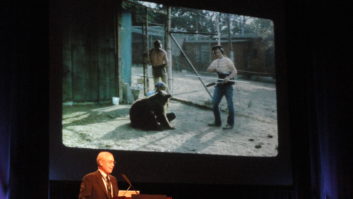
About halfway through writing this month’s cover story on the revamp of the Newman Scoring Stage at Fox Studios, it dawned on me that over my 30 years at Mix, I’ve had the rare opportunity to step on the wooden floors and walk the length and width of all the major U.S. film scoring stages operating at the time, even stopping to clap my hands in the middle of the room, pretending as if I could recognize the snap and decay characteristics. Everybody else does it, I figured. Play along. I could certainly get a sense of the massive cubic volume from the long tail.
When I say that there are a handful of scoring stage floors, I’m talking about the top-end, Hollywood-style rooms, those that can host a 100-piece orchestra comfortably and manage complex sessions with no down time. In New York City, for a brief time, there was Hit Factory, with its famous debut picture of seven Sony 3348s lined up against the back wall, followed soon by Right Track’s expansion into the West Side. Both are now gone.
I’ve spent more than a few hours up at Skywalker Sound in the San Francisco Bay Area, visiting Leslie Ann Jones on the massive scoring stage and watching her at work on everything from the SF Symphony to the Kronos Quartet, set up in a simple circle in the middle of the 80×60-foot space. I once even attended a press junket on The Ranch where Mercedes-Benz rolled out a Roadster as part of the relaunch and drove it onto the stage to demonstrate its 12-speaker, 5.1 audio system as part of the $175,000 price tag.
In Los Angeles, Paramount and Todd-AO have been shuttered, as far as I know, leaving the Big Three standing at Sony Pictures Studios, Warner Bros. and Fox Studios. The Streisand Scoring Stage at Sony is part of our annual Mix Presents Sound for Film & Television event, its walls unchanged since the tracking sessions for The Wizard of Oz.
The first time I actually witnessed a full orchestra in action was at the Eastwood Scoring Stage at Warner Bros. I was in Los Angeles doing another story, and a friend invited me by to a session written and conducted by the great Bill Conti for The Scout. I was free to walk out into the room, sit down in the dusty, overstuffed, 40-year-old red couch and listen. And watch. At one point I leaned over to my engineer friend and asked, “So this is the first time these musicians have ever seen the music?” He said it was. To me it seemed flawless on the first take. I was amazed. I was also struck by the speed and efficiency in their work. High pressure, a large team in the control room, and so smooth in running through cues, then on to the next. Today, I guess, we call that “workflow.” These rooms, I saw, had impressive workflows, even with 1990s technology.
And the last time Mix visited Fox Studios, it was to cover the opening of the newly renamed Newman Scoring Stage, with a larger, 5.1 surround control room and Genelec main monitor system. Mel Lambert, I recall, covered the inaugural session where they re-recorded the classic Fox introductory fanfare in 5.1. Twenty-two years later, the Newman Scoring Stage is on the cover, with the installation of a new 7.1 Meyer Sound Bluehorn System. Changes don’t come frequently at the high end of the film scoring industry. When they do, they are noteworthy.
Of course, award-winning scores don’t need a large scoring stage and union players to tell their stories. Heck, much of Hildur Guanadottir’s Oscar-winning score for Joker was initially recorded in her Berlin apartment studio and later filled out on the stage. And many top composers today work in smaller sections, with horns one day, strings the next, supplemented in the end by high-quality virtual instruments.
And scores can be created in Seattle, Salt Lake, Charlotte and Nashville, where Ocean Way has made a nice little business hosting top videogame composers, bringing up to 65 pieces into their main room. A quality score can be created anywhere, in a hundred different ways.
But at the top end, where Fox, Sony, WB, Skywalker and the like rub shoulders with Abbey Road and the great halls of Europe, tradition remains. The studios themselves don’t really change at all. As James Nichols once told me, “You can still smell Frank Sinatra’s cigarettes in the walls.”
And yet, these recording palaces manage to stay current in their control rooms and operate at a level of efficiency and quality that remains a model for the entire recording industry. Heck, Skywalker Sound just went full-on immersive in its control room. And Fox has been designed to pop in ceiling speakers at a moment’s notice. Thoroughly modern in approach, with a glimpse at nearly 100 years of recording through the glass. Now that’s a legacy to be proud of.



